Follow
the podcast on

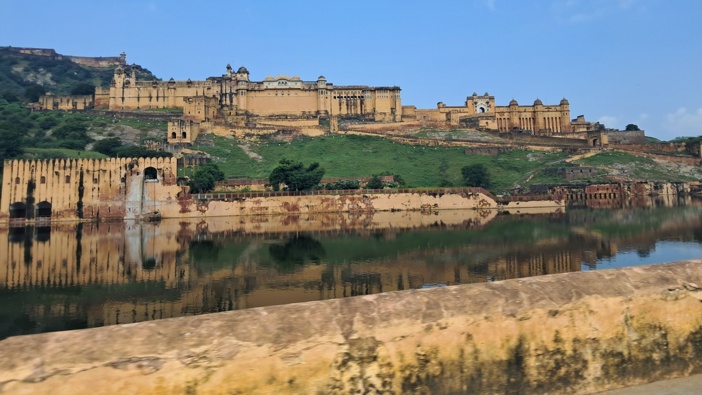
When it comes to grand gestures, painting your entire city in the one colour is quite something. So much for painting the town red. How about pink? Jaipur beckons as one of India’s most enchanting destinations, where the Old City is harmoniously bathed in the same pink hue. The elegant capital of Rajasthan was painted in pink stucco in 1876 to welcome Albert Edward, the Prince of Wales, who was the son of Queen Victoria and later became King Edward VII. Jaipur’s Maharaja chose the colour because pink symbolises hospitality in Rajput culture, and the gesture impressed the Prince so much that he nicknamed the city the "Pink City." The name – and the stucco - has stuck ever since. A year later, a law mandated that all future buildings in the Old City must be painted pink.
As I swept into Jaipur on a private holiday Wendy Wu Tours, there’s no denying how that welcoming palette sweetly seduces even the most jaded of travellers. Jaipur effortlessly casts you under its spell, as you delve into its rich history and treasury of enticements. There is an unmistakeable magic about the place. Nearly 300 years ago, an enlightened maharajah with a penchant for jewels and a keen eye for architecture built this planned city, wedged between the arid hills of northwest India. Built in the form of a rectangle, Jaipur was divided into nine blocks, seven for public use and two reserved for the state’s most prestigious palaces and buildings. The entire city was girdled by a formidable protective wall.
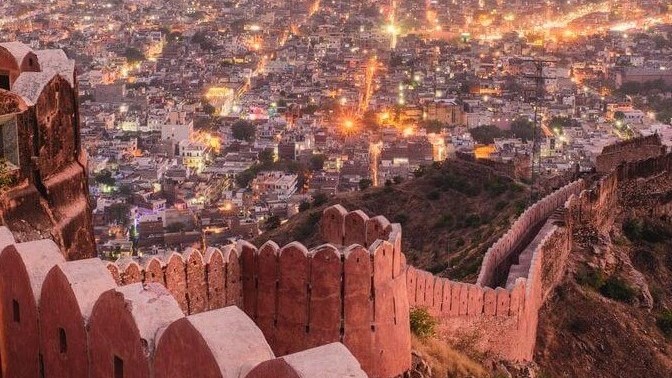
Called Jaipur after the city’s founder, Jai Singh II, the planned city soon gave rise to astonishing royal palaces and vast workshops of artisans recruited to establish a new commercial hub. These days, gem cutters, jewellery designers and garment-makers are still doing a flourishing trade in Jaipur. And the royals still occupy a wing of the majestic City Palace, while gleaming mid-rise towers and a new subway system anchor Jaipur’s forward march. But for all the contemporary progress, it’s the architectural grandeur, proud sense of place and thriving craftwork traditions that make this destination so infectious. Street markets are splashed in colour and handicrafts, and Hindu temples can be found nearly every 100 metres. Though the streets heave with beeping and belching traffic, aimless tourists and dung-dropping cows, there is a charm and charisma to the carnival of commotion.
Close to City Palace, my wonderful Wendy Wu Tours guide Vipin treated us to some sizzling old-school retail therapy. We walked under the peeling pink porticos of the roadside bazaars which were emblazoned with everything from puppets to pyjama pants; passing by carts of fried chickpea cakes, and marble-lined shrines with statues of Hindu gods. Garment-hunting was high on the agenda, for gifts to take home. Vipin led us to his favourite shop, where an explosion of colourful fabrics heaped in piles and stacked to the ceiling soon greeted us, as attentive staff served us Masala chai. Whether you’re after local, authentic t-shirts, shirts, trousers, scarfs, saris, rugs, cushion covers, towels or table-cloths…this is textile and garment-shopping heaven. As my sister snapped up some sensational saris, I haggled down the price on a sublime tablecloth with block-printed red elephants. The other boom retail business is jewellery, because Jaipur is a global centre for cutting and polishing precious and semiprecious gems. Head to Jewels Emporium’s stately white building and take a tour of the workshops, where cutters shape facets, and men at workbenches adorn gold settings with jewels, and rinse the gold dust from their hands in wash basins. That water is later sold to extraction companies. The quality of the workmanship is second to none, true Rajasthan’s abiding legacy.
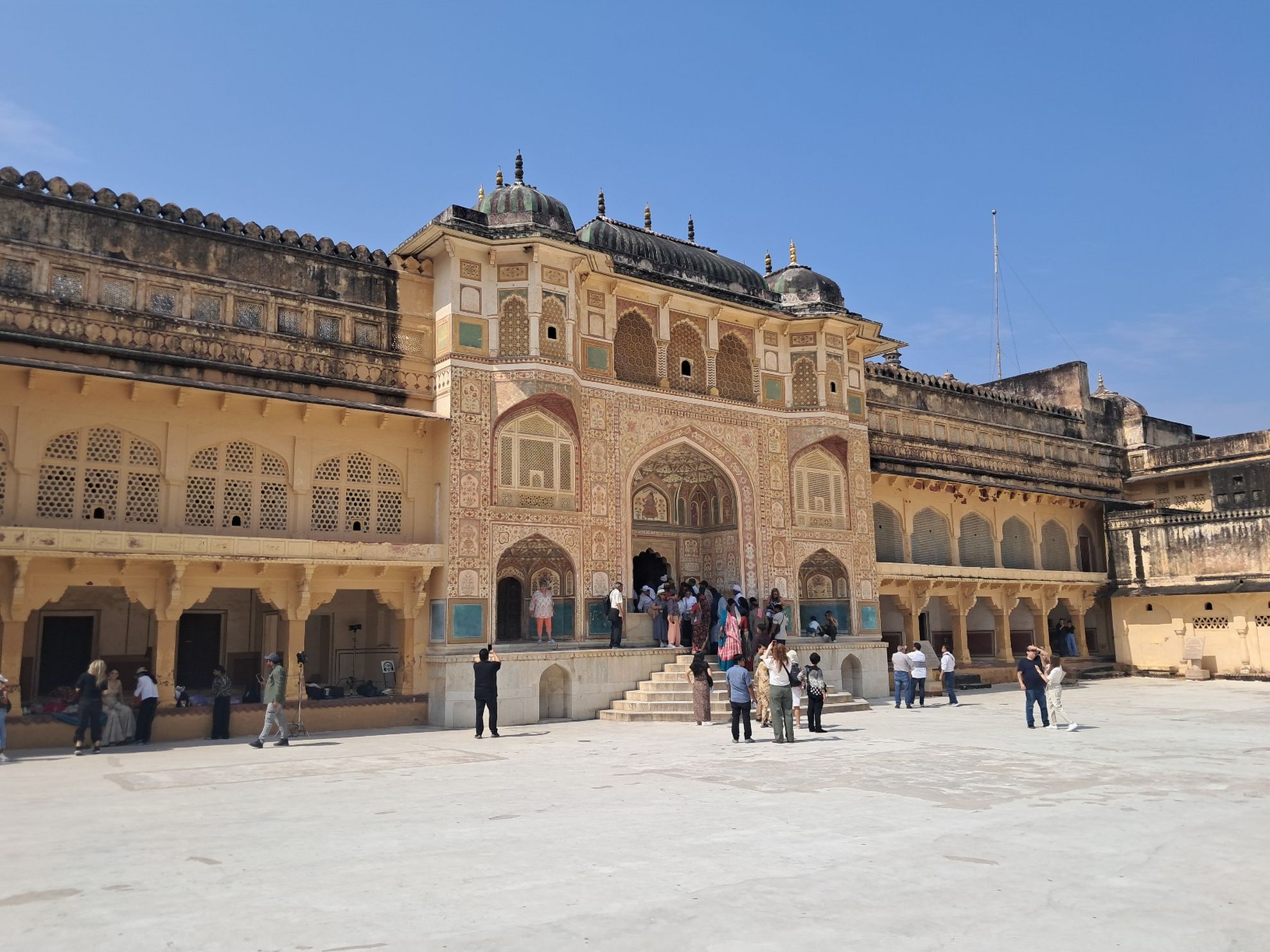
Jaipur’s Pink City bragging rights is best epitomised by the Hawa Mahal, or Palace of Winds. We stopped by to pose in front of this five-story palace façade, constructed from pink sandstone. Built in 1799, its iconic facade features 953 small windows which allowed royal women of the court to observe street processions without being seen while also creating a natural cooling effect. The palace's architecture is a blend of Rajput and Mughal styles, ornately designed with protruding bays of lattice stonework and cupolas mimicking Krishna’s crown. Could there be a more glorious façade in the world?
City Palace is a stirring complex to leisurely explore, peppered with mouth-watering architecture, tranquil courtyards and lush gardens. The prize draw is the Palace of the Breeze, a triumph in building design, whereby the air circulates so efficiently that it keeps the occupants cool even in the extreme summer months, when the mercury can nudge 50 degrees. The on-site museum is studded with royal treasures, costumes and curiosities. Out in the courtyard, I admired some massive silver vessels that carried the Maharaja’s drinking water from the Ganges River to London in 1902 for Edward VII’s coronation.
You can see the royal reception rooms that are still in use, where Jaipur’s royal family entertain guests in an ornate dining room and parlour, where chairs have silver lions for armrests. The walls are painted with gold dust and extracts of rubies and emeralds. Yipin pointed out where the royal family reside. There’s a lot of tabloid tattle about Jaipur’s current Maharaja, Pacho Singh. He’s only 27, quite the polo-playing playboy and is currently living in the palace with his French girlfriend. But it’s fully expected he cannot marry her, in deference to royal tradition and Rajasthan’s adherence to arranged marriages and astrological alignment.
Beyond the Old City, no visit to Jaipur is complete without savouring the sky-piercing magnificence of the four-hundred-year-old Amber Fort. (Pronounced Ah-meer.) Sprawling across the upper reaches of a hillside like a scene out Return of the Jedi, this fortress was previously the seat of power for the Rajput kings from 1599, before relocating to Jaipur’s Old City just over a century later. En-route to the fort, Vipin led us to the most dreamy viewpoint, on the shores of Lake Maotha, where we gazed up in awe at this hilltop colossus. Brightly dressed elephants lumbered by, readying to carry visitors up the slope to the fortress. I had previously taken an elephant ride up to Amber Fort, but I’ve put weight on since then and am more mindful of animal welfare.
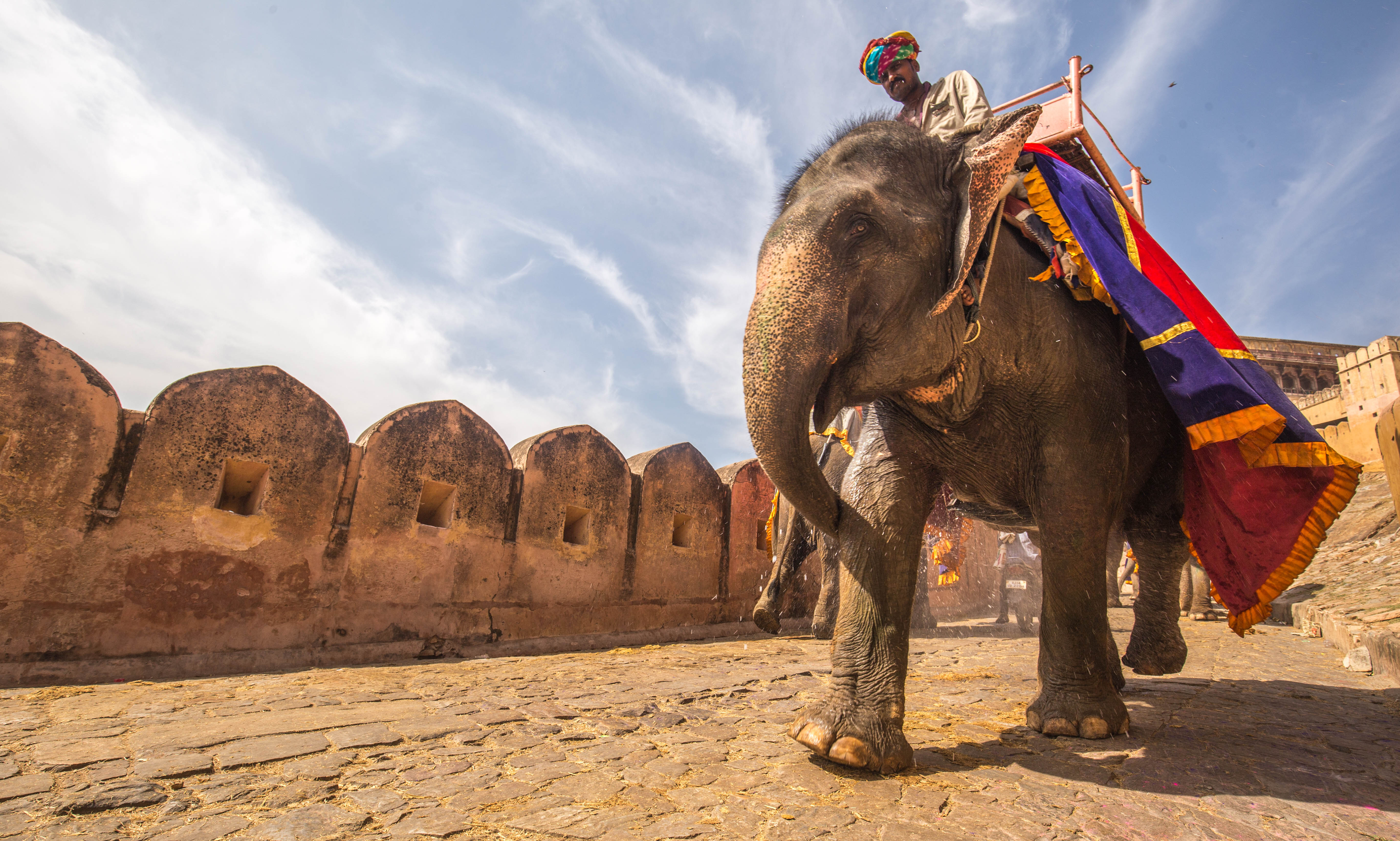
We opted for a jeep ride through the skinny lanes snaking their way up to Sun Gate. From here, we marvelled over the China Wall-esque fortifications, the Amber Wall, riding across the ridgelines as far as the eye can see. ( It’s 12km in length.) But this Rajput stronghold hooks in the tourist hordes principally for its gobsmacking array of palatial buildings and extravagant ornamental gardens. In shades of honey and rose stone, white marble and gilt decor, it’s a frothy fusion of ornate Hindu and Islamic design. Amber Fort’s exquisite craftsmanship is best exemplified by the Mirror Palace, or Sheesh Mahal.
Candlelight dinners would have been next-level. A single lit candle spangles the beautifully cut Belgian glass panels and mirror mosaics that festoon the walls of the banquet room, transforming the space into a night-sky kaleidoscope across the walls and ceiling. Apparently, this room was made by the Maharaja so that the Maharani (queen) could see the stars at night, as she was not allowed to sleep in the open. Other highlights include the many-pillared Diwan-i-Am, the Hall of Public Audience; the Jal Mandir, or Hall of Victory, which features carved marble panels, a mirrored ceiling, and expansive views over the ramparts of the fort. The Sukh Niwas, the Hall of Pleasure, is another drop-dead-gorgeous marble room that was cleverly cooled with water. Here, the Maharaja reportedly relaxed with his ladies. Amber Fort is a resplendent blockbuster, reverberating with the glory days of Rajput rule in Rajasthan.
Jaipur residents are rightly proud of their architectural showstoppers. One of the signature attributes to the city is the fact that some historic palaces, no longer required for the affairs of state, have been reimagined as beacons of hospitality. But I stayed at a brand-new luxury build that is a grand triumph of contemporary construction, fully inspired by Jaipur’s landmarks and Rajasthani finesse. Introducing Anantara Jewel Bagh Jaipur. Whether it’s for a big bling-bling Bollywood wedding or for immersive luxury experiences away from the heaving throng of Jaipur’s tourist spots, this hotel delivers a tour de force in lavish Rajasthani living, with a contemporary take. It is splendour defined. As our Wendy Wu Tours driver pulled into the entrance, a troupe of Rajasthani dancers and costumed drummers serenaded our arrival in spectacular, effervescent style.
Unfurling over 5.5 lush acres, the grand hotel’s money shot is its sensational main façade, drawing rich inspiration from Amber Fort and Rajasthan’s royal palaces. Features include majestic arches, intricately designed jharokhas (bay windows), and graceful chhajjas (overhanging eaves) and detailed carvings. It was thoughtfully painted in the same colours as Amber Fort’s walls during golden hour. Rajputana history and heritage permeates the hotel. You’ll notice it in the materials—yellowstone from Jaisalmer, marble from Banswara and Makrana, and locally sourced timbered. There’s the treasury of sublime artworks, notably including portraits of Rajput warriors and royalty. Peek inside the Rang Mahal ballroom, where the walls are completely covered with celebratory nods to the state’s heritage. It was handpainted over two-and-a-half years by third-generation artists. Delicate thikri glasswork, hand-carved wood accents, and intricate gold leaf detailing abound across the hotel.
Amer Bagh garden venue unfurls like a verdant blanket at the base of the hotel – and is a stirring outdoor venue. Jai Bagh (victory garden is the main outdoor space for guest and I was absolutely enthralled delving into the daily bazaar that is staged here in the afternoon, complete with puppeteers, block printers, bangle makers and astrologers. Anantara’s core DNA is to create hotels steeped in local elements and the Jaipur addition excels at delivering exactly that. You can even go chowk-hopping, vegetable shopping and cooking with local women.
The hotel boasts 150 rooms and suites, layered across five categories, with most overlooking the inner courtyard or Jai Bagh. We stayed in the Anantara One-Bedroom Terrace Suite, which is kitted out with its own outdoor Jacuzzi and expansive terrace. I was transfixed here watching muscular monsoon thunderstorms tear up the sky and soak the land! Guestrooms do not skimp on celebrating the sense of place, with sumptuous comforts and artful design elements, from the zardozi on the pillows, thikri work on the headboards, wooden jharokas by the window nooks, and Mughal miniature art on the walls.
If that’s not enough to tempt you, Anantara’s first outpost in India will enchant you with its gastronomic verve. Led by Executive Chef Sunil Jajoria, Sheesh Mahal is a pinch-yourself jewel box of a venue, to experience the true essence of Rajasthan with exquisitely fitted out with glittering mirror mosaics, dressed in 350,000 pieces of glass, inspired by the legendary Mirror Palace. Coud there be a more wondrous place to savour the true essence of Rajasthan’s culinary brilliance? The menu marries traditional Rajasthani delicacies with global influences, paired with signature cocktails like the Jewel of Jaipur.
Jajoria, a Rajasthan native, has been researching local cuisine for the last seven years. Perfected over 20 trials, his menu dives deep into how maharajas entertained. His tasting menu kicks off with hummus that tastes like Bikaneri bhujia, moving on to ker sangri kebabs, besan kebabs mimicking paneer (as there was no paneer in the history of Rajasthan, says the chef), and Shekhawati maas tacos. The menu is handwritten by the chef himself, on vintage paper he has been collecting since his he was a boy. Pair this menu with the ‘Echoes of Distillation’ spirit tasting of heritage liquor from the royal family of Mahansar. It’s mixology at its finest, with no shortage of artful theatre thrown in.
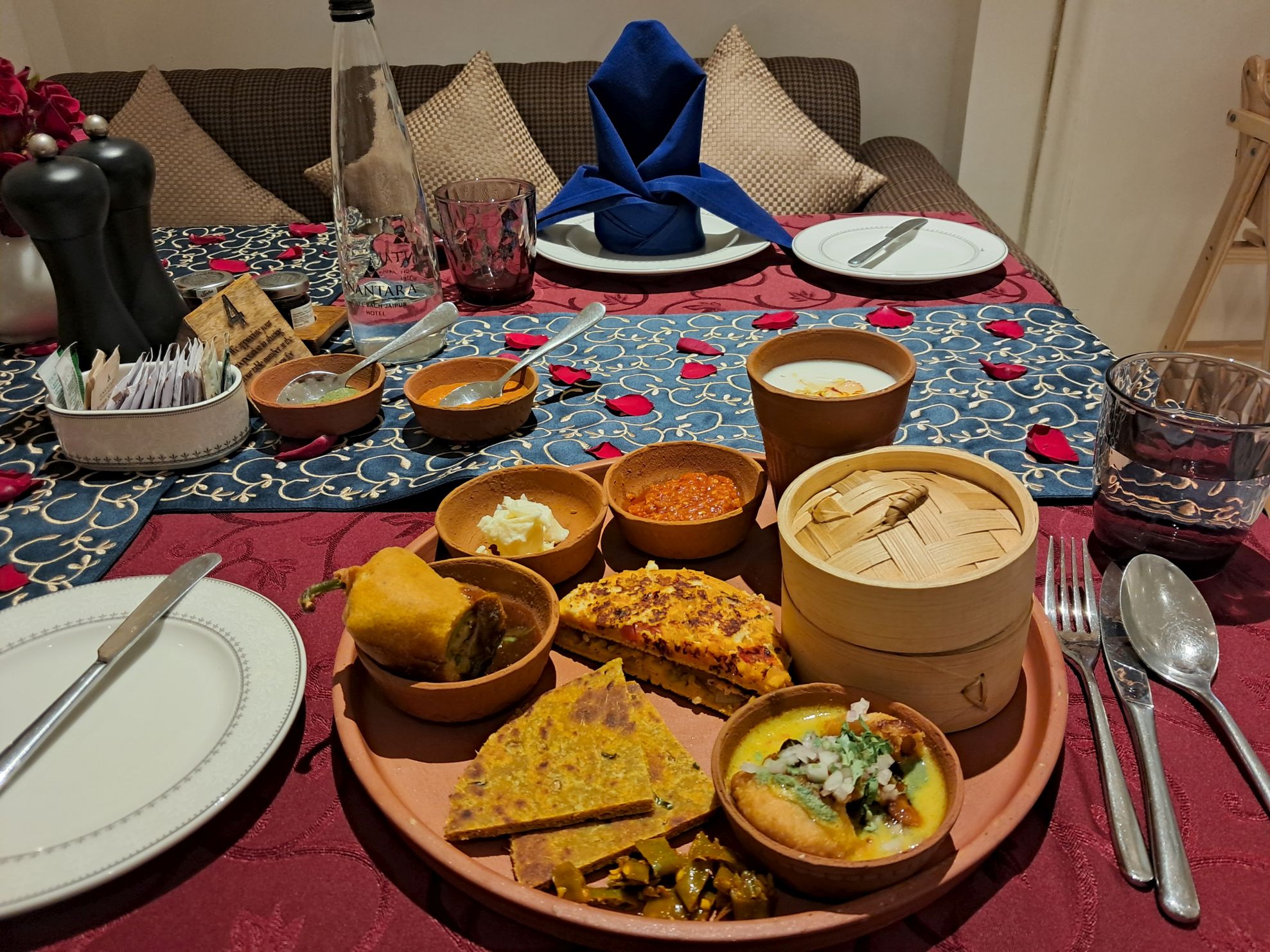
Another cracking experience is Amrit Mahal, the vibrant all-day dining venue, which presents a diverse array of international and Indian specialties. There were too many highlights to recount, but the lamb baos, edamame truffle dimsums, lotus root on fire, Cantonese buttermilk prawns, soba noodles, and Japanese caramel cheesecake were all pleasurably devoured. The buffet breakfast here is like a royal banquet!
The spa experience is a signature feature pillar of any Anantara property, and resident experts were brought in from Thailand to train the Jaipur team. The treatment repertoire remains consistent with their global spa menus—a mix of Ayurveda, Thai massages, and western therapies. I deployed my sister to the spa for some personal panel-beating and she is still buzzing about the deep tissue massage she savoured. She rates it as the best massage of her life, “life-affirming, age-reducing and liberating.”
Another starring attribute of the hotel is its genuine sense of connection with the community. As a part of their grassroots outreach, the hotel works with local women to make the rotis on their menu on a chulha or traditional clay stove. You can take an early morning trip to the flower market or a guided farming experience. Even better, take a private visit to Hathi Gaon, which is a community of rescue elephants residing in their natural habitat. Or partake in a local culinary class. I was particularly impressed that the hotel takes care of their staff’s accommodation needs, building nearby apartments to ensure they are well-housed. Hospitality is as sparkling as the palace-like hotel itself - faultless, ultra-attentive, charismatic and truly unforgettable. Treat yourself to a remarkable Jaipur escape at Anantara Jewel Bagh. You’ll be royally treated from the moment you arrive. You will not want to leave. www.anantara.com
Delve into India and the Golden Triangle with the award-winning tour specialists across Asia and beyond. I chose a tailor-made Classic India private holiday, that enables you optimise your itinerary and accommodation preferences, as much as you wish. The itinerary can be as active or as laid back as you are, with full flexibility over included meals and excursions. You’ll be in the best of hands with Wendy Wu Tours. www.wendywutours.co.nz/india
From New Zealand, it’s just a one-stop connection to a multitude of destinations in India, including New Delhi, with Singapore Airlines, on their various daily services from Auckland and Christchurch to Singapore. Enjoy well-timed connections for an easy transit in Singapore. Across all classes of travel, the award-winning carrier has not only fostered a world-beating reputation for its exceptional customer service and in-flight product, but also its innovation. Become a KrisFlyer member and enjoy complimentary in-flight WiFi. For best fares and seats to suit head to https://www.singaporeair.com
Mike Yardley is our resident traveller on Jack Tame Saturday Mornings.
Take your Radio, Podcasts and Music with you









